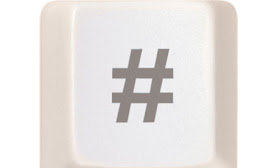 |
| Courtesy of Andrew Barr for the National Post. |
It's the number sign. It's the pound sign. It's the hashmark, hash mark, hash tag, hashtag, or hash key. It's the octothorp, octothorpe, octathorp, or octatherp. It's a tic-tac-toe frame. It's a musical sharp symbol. It's a hex key. It's a space key for editing. It has mathematical, computing, and topographical import. It can even mean "checkmate". It has many more meanings as well.
Just as email gave the @ symbol a new purpose, so twitter has given the # symbol a new function. Tweeters use it to catalog their tweets, and thus are able to build interest-based communities. #fridayreads and #ff followed by a space and an @ sign will send the message out to your intended audience and group themselves respectively. Used in front of a subject, you don't have to wade through similar words or phrases to find all the tweets on that subject. It's known as a hashtag on twitter.
 |
| Logo for twitter. |
Before twitter most of us used it to denote a number ("I like #2 pencils"), or punched it on the telephone when communicating with frustrating machinated voice directives. On touch-tone phones in the United States it's called the pound key. In the U.S. we also use it to denote "pound" as a unit of weight.
 |
| Image courtesy of The Guardian. |
But in the UK the term "pound sign" refers to - £ - the currency symbol for a pound sterling, and never a unit of weight. There the abbreviation "lb" is used to denote weight, which comes from the Latin libra pondo meaning "a pound of weight".
As for octothorp and its spelling variations, the "octo" is pretty obvious: there are eight points to the figure. There are several explanations for the "thorp/thorpe/therp" part. It could be meant to honor the 18th century British general, James Oglethorpe, founder of the colony of Georgia (per the American Heritage Dictionary). A more intriguing explanation is that it comes for a symbol on old maps for a village - the center being the village square with eight plots surrounding it (per the British journal New Scientist, 1996).
 |
| James Edward Oglethorpe by Alfred Edmund Dyer, circa 1735-1736. Image courtesy of the National Portrait Gallery, London. |
But the most popular story is that it was invented by Bell Labs engineers who wanted to honor Native American athlete Jim Thorpe, a winner/non-winner/winner of the 1912 Olympics pentathlon and decathlon (read up on him, it's interesting). The Bell system is credited with bestowing the name "octothorp" in 1974 (per the OED).
 |
| Jim Thorpe at the 1912 Olympics. Image courtesy of Wikipedia. |
Despite its similarity to the musical sharp notation - ♯ - there are differences. The sharp sign must have slanted parallel horizontal lines (rising from left to right) The number/octo/whatever sign must have perpendicular parallel horizontal lines. Perpendicular vertical lines must be in the sharp sign, while the number sign can have true vertical or slanted ones. In this way the number sign can have an italic appearance.
From relative obscurity as a punctuation mark, like its buddies &, © and ®, it now enjoys long-lost popularity. No need to ever design new marks when the old ones can be re-purposed. Hence it gives hope for a renaissance of punctuation forms.
***************
*******************************



No comments:
Post a Comment
NOTE: COMMENTS WITH LINKS WILL NOT BE POSTED!